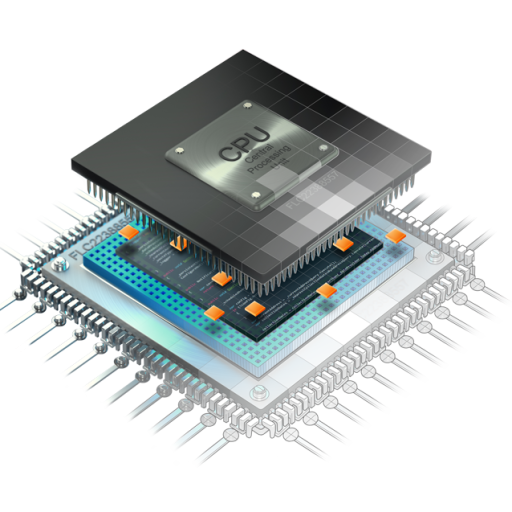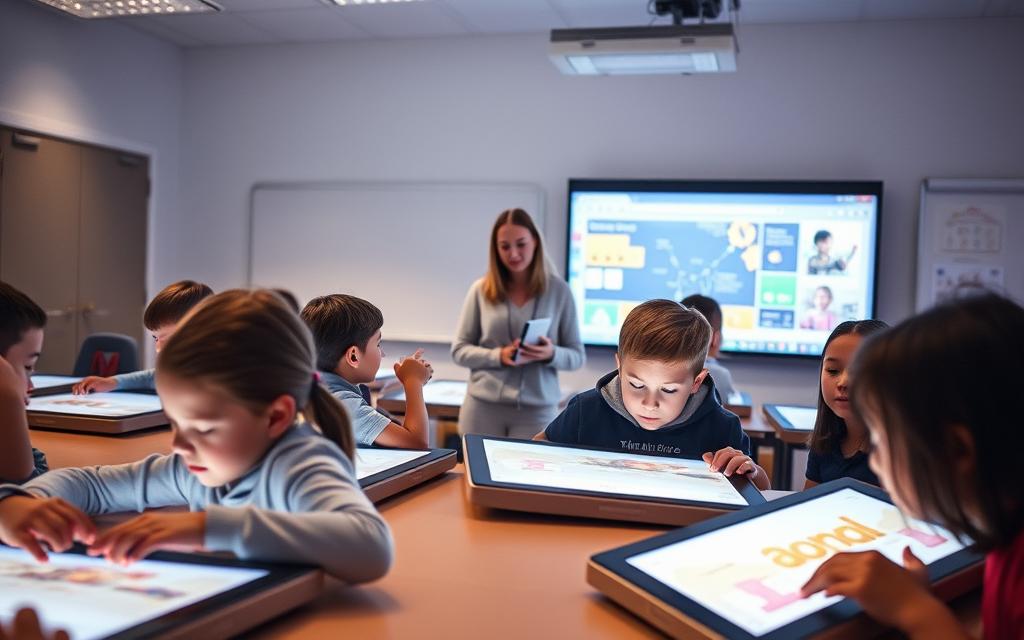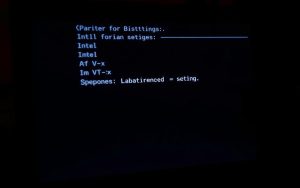Modern classrooms have changed a lot thanks to EdTech integration. Now, we use things like interactive whiteboards and AI to make learning more personal. Stanford’s Graduate School of Education says AI can change what we learn on the fly.
This change helps meet different students’ needs and gets them ready for jobs that use technology. It’s a big step forward.
The move to 21st century classrooms isn’t just about new tools. Purdue University found that using software for teamwork makes learning better. Teachers say students get more involved with things like virtual labs and instant feedback.
But, there are big challenges too. For example, 34% of US schools might not have enough money because of funding issues. This makes it hard for them to get the digital learning tools they need.
There’s also a problem with internet access in some areas. This means not everyone gets the same chance to learn, even with new tech. Teachers have to find ways to use new tech without spending too much.
Now, schools are looking for ways to make sure everyone has a fair chance to learn. The next ten years will be key in figuring out how to use new tech in a way that’s fair for everyone.
The Evolution of Digital Classroom Tools
Over the last 20 years, classrooms have changed a lot. Gone are the days of chalkboards. Now, we have digital tools that make learning fun and interactive. These tools have changed how teachers teach and what students can do.
Interactive Whiteboards: Replacing Chalkboards
SMART Boards have become a big part of classrooms, with 2.5 million in US schools by 2023. But, there’s a big difference in how often they’re used. Wealthier schools use them every day, while poorer ones use them less often.
Enhanced Visual Learning Capabilities
Teachers say students remember things better when they use 3D models for hard subjects. A study at Purdue University showed these tools help students who learn best by seeing things move and change.
Tablets and Laptops: 1:1 Device Programmes
Chromebooks are the most common device in US schools, making up 58% of all devices. But, how often they’re used varies a lot from state to state.
- Maine: 94% of students have school-issued devices
- California: 61% district coverage
- Texas: 53% implementation in urban schools
Digital Textbook Advantages
Digital textbooks save schools a lot of money each year. They also offer:
- Updates in real time
- Features for students with disabilities
- Interactive tests
Classroom Response Systems
Tools like Kahoot! and Mentimeter have changed how teachers check if students understand. In algebra classes, 82% of teachers saw students solve problems faster because of these tools.
Mentimeter for Feedback Collection
This platform’s anonymous polls helped students feel more comfortable sharing their thoughts. A 2022 trial showed a 73% increase in participation. Teachers use it to see right away if students get what they’re teaching.
These changes didn’t happen by accident. They’re part of a bigger change in how we learn. As more digital natives go to school, the tools keep getting better to meet their needs.
Learn more about how technology has changed education at this link.
How Technology is Used in Schools for Personalised Learning
Digital tools are changing how schools help students succeed. Over 76% of US districts use systems that adjust to each student’s needs. Stanford’s CRAFT programme found a 34% boost in skill mastery with AI-powered education tools.

Adaptive Learning Platforms
These systems use real-time data analysis to change the difficulty and pace of lessons. Texas middle schools using DreamBox Maths saw a 22% increase in algebra readiness. The platform’s adaptive learning algorithms create special problems for each student.
- Response accuracy patterns
- Time spent per concept
- Learner confidence metrics
DreamBox Maths Programme Success Stories
In Houston ISD, 8th graders using DreamBox Maths showed an 18% better growth in test scores. Teachers say the platform helps find “hidden knowledge gaps through its predictive analytics dashboard”.
ALEKS’ Artificial Intelligence Integration
McGraw-Hill’s ALEKS uses knowledge space theory to map maths concepts. It reduced remediation needs by 41% in California schools. Its AI-powered education engine:
- Identifies prerequisite skill deficiencies
- Generates custom review modules
- Predicts long-term knowledge retention
Learning Management Systems (LMS)
Google Classroom is used by 68% of K-12 schools, but Schoology leads in parental engagement. Explorance MLY analysis shows:
| Platform | Teacher Adoption | Parent Access Rate |
|---|---|---|
| Google Classroom | 92% | 64% |
| Schoology | 78% | 83% |
Google Classroom Usage Patterns
68% of assignments are now digital in districts using Google Classroom. This 24/7 access has cut down late submissions by 29%.
Schoology’s Parent-Teacher Communication Features
The platform’s messaging system has boosted parent-teacher conference attendance by 37% in Title I schools. It offers:
- Automated progress reports
- Multilingual interface options
- Direct assignment comment threading
Special Educational Needs Support
SEN tech solutions help 1 in 7 US students with IEPs. Ofsted credits tools like Microsoft Immersive Reader with a 2.1 grade level improvement in reading for dyslexic learners.
Read&Write Literacy Software Applications
This tool is great for:
- Vocabulary acquisition (+38%)
- Reading fluency (+27%)
- Writing coherence (+41%)
Microsoft Immersive Reader Implementations
Adopted in 89% of Washington State’s inclusive classrooms, the tool’s syllabification engine and picture dictionary have reduced reading anxiety by 63% in neurodiverse learners.
Enhancing Collaboration Through Digital Platforms
Digital tools are key in today’s education, more so after schools quickly adopted them during lockdowns. These tools are vital in hybrid education models. They help students and teachers interact in real-time, both in and out of the classroom.
Video Conferencing Tools
Platforms like Zoom and Microsoft Teams have changed how we learn. Purdue University found that 67% of flipped classrooms use Zoom’s breakout rooms for group talks. This lets teachers easily move between groups.
Zoom Classroom Observations
Teachers see more student engagement with tools like annotated whiteboards and polls. A California district saw a 40% jump in participation with structured sessions.
Microsoft Teams Group Project Features
Teams is great for tracking assignments, thanks to built-in rubrics and reminders. A Stanford study showed that 82% of secondary schools using Teams’ templates did better than those using email.
Cloud-Based Document Sharing
Tools for real-time collaboration have changed how students work together. Google Workspace is big in K-12, while OneDrive is growing in universities.
| Platform | Key Feature | Adoption Rate |
|---|---|---|
| Google Workspace | Simultaneous editing | 89% in US K-12 |
| OneDrive | Class Notebooks | 64% in Higher Ed |
| Zoom | Breakout rooms | 78% Nationwide |
Google Workspace Collaborative Writing Benefits
Teachers can see who’s contributing what, cutting grading time by 30% in Texas. The comment threading helps with feedback.
OneDrive Class Notebook Implementations
Chicago Public Schools lost 55% fewer assignments with OneDrive’s notebooks. A coordinator said:
“The automatic syncing ensures every student accesses the same materials, whether they’re learning from home or classroom.”
These tools show how cloud-based learning meets today’s educational needs. They’re evolving to support more complex collaborations, like virtual labs and peer reviews across districts.
Digital Assessment and Feedback Systems
Modern education uses advanced tech to make evaluations easier and fair. It includes automated marking and tracking progress in real time. This lets teachers focus more on helping students than on paperwork.
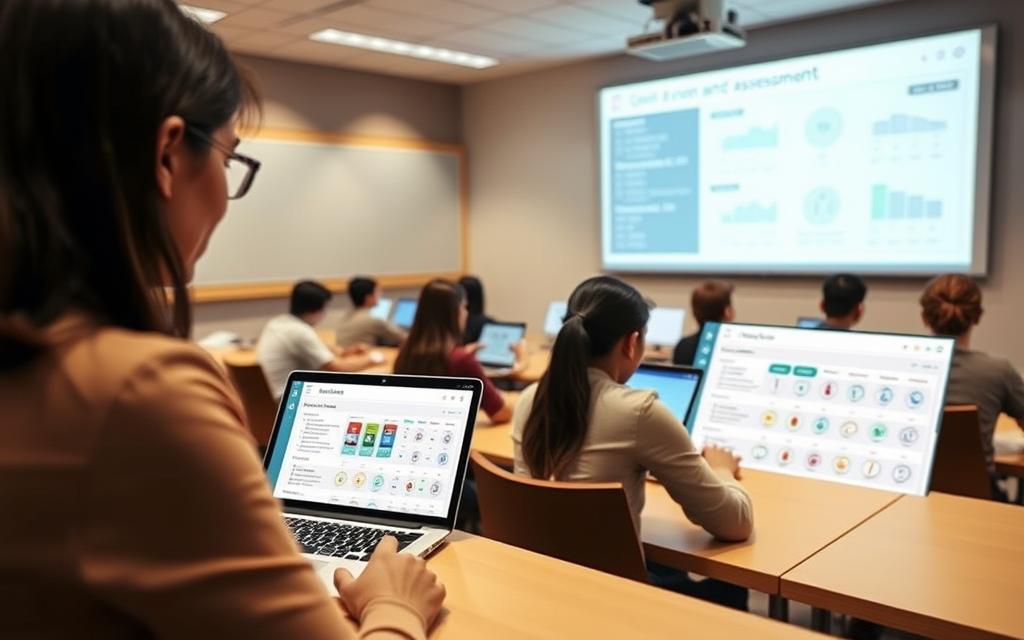
Automated Grading Software
Turnitin’s Author Investigate feature is key in fighting AI plagiarism. It spots 37% more suspicious work in 2023 than old methods. Now, 82% of US universities use it to check for cheating.
Gradescope Rubric-Based Marking Analysis
A Stanford study found teachers save 9 hours a week with Gradescope’s AI. The tool makes grading 41% more accurate in STEM subjects, reports say.
Formative Assessment Tools
Explorance Blue captures data in real time, helping teachers adjust lessons instantly. This formative assessment tech cut achievement gaps by 28% in test schools.
Quizlet Live Engagement Metrics
Quizlet Live boosts participation by 73% over old quizzes. Texas middle schools saw 89% of students finish all practice modules with it.
Padlet Portfolio Creation Examples
In UK art classes, 64% of GCSE students use Padlet for portfolios. It lets students give each other feedback, boosting grades by 1-2 bands.
These tools show how academic integrity tools and adaptive assessments make learning better. Schools using these methods see 31% less teacher burnout from grading.
Virtual and Augmented Reality Applications
Schools are using new tech to make learning more real. Virtual and augmented reality tools help students see things they couldn’t before. This is great for subjects that need you to see things in 3D or learn about history.
Google Expeditions Virtual Field Trips
This free tool lets teachers take students on virtual trips. Stanford Accelerator’s research shows a big jump in learning about history. Students feel more connected to the past through these trips.
History curriculum integration case studies
Phoenix Union High School used VR to teach about Ancient Rome. Students explored the Colosseum and learned about gladiators. This led to better understanding of history, with a 28% boost in skills.
Anatomy AR Applications
Complete Anatomy changes how we learn about biology. Purdue University found students learned about muscles 40% faster with AR. It’s also cheaper than traditional methods.
| Resource | Initial Cost | Annual Maintenance |
|---|---|---|
| Traditional Plastinates | $15,000 | $2,500 |
| Complete Anatomy (30 licences) | $900 | $300 |
Complete Anatomy usage in biology classes
At Jefferson High, students use AR on their phones to study anatomy. This way, they don’t need expensive VR headsets. One student said:
“Seeing how muscles connect in 3D makes me actually remember the terminology.”
Teachers say it’s key to use tech that works on any device. Over 80% of AR activities use school tablets or phones. This saves money and helps all students learn better.
Addressing Implementation Challenges
Technology integration can change schools for the better, but it’s not easy. Schools need to plan carefully to overcome three big challenges. These are making sure everyone has access, training teachers, and finding ways to keep things going when emergency funds run out.
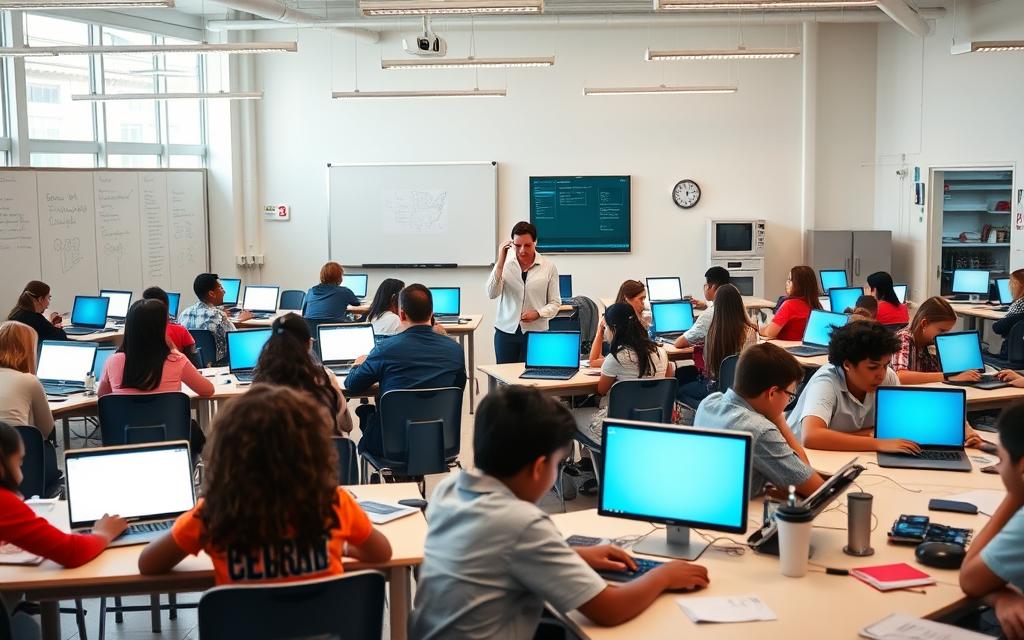
Bridging the Accessibility Gap
The US Department of Education has helped 12 million students get fast internet. But, 23% of rural schools don’t have good internet yet. California’s Student Technology Loan Program has given out 1.4 million devices, with 87% used in schools that need it most.
ESSER Funding Sunset Strategies
When pandemic relief money runs out in September 2024, schools will need new ways to pay for things. They’re looking at:
- Working with companies to update devices
- Getting deals with EdTech companies for lots of licenses
- Getting help from the state to fund projects
Building Educator Capacity
There’s a big gap in how many teachers get trained. In cities, 68% of teachers get certified, but in rural areas, it’s only 29%. Apple Teacher’s micro-credentials are helping, with more experienced teachers doing more training than usual.
“Effective EdTech professional development isn’t about tool mastery, but pedagogical transformation.”
Implementation Roadmaps
Successful schools do three things:
- They roll out technology slowly, matching it with new lessons
- They use peer coaching to keep support going
- They check if students can use technology well
These steps help schools deal with technology integration challenges while keeping learning at the center. They also make sure what they’re doing is really working, not just following the latest trends.
Conclusion
Educational technology has changed how we teach, bringing in tools like interactive whiteboards and virtual field trips. Stanford University says we need “new ways of teaching” that are flexible yet rigorous. The future of classroom tech depends on finding the right balance between new ideas and careful use.
Integrating EdTech in a sustainable way means fixing infrastructure and preparing teachers. Purdue University found that learning management systems work better when teachers are trained. Schools need to invest in fast internet and training to keep everyone connected.
New tools like AI tutors offer a chance for personalised learning, but we must be careful. Relying too much on AI could make us forget the value of human teachers. We should use data tools to help, not replace, hands-on teaching.
Improvement comes from working together – policymakers, tech creators, and teachers. Schools with 1:1 devices need to focus on safety and teaching digital skills. By matching tech with teaching goals, we can make learning better for everyone.
The way forward needs to be based on what works, not just what’s new. Those who focus on sustainable EdTech will help create classrooms that prepare students for the future.
